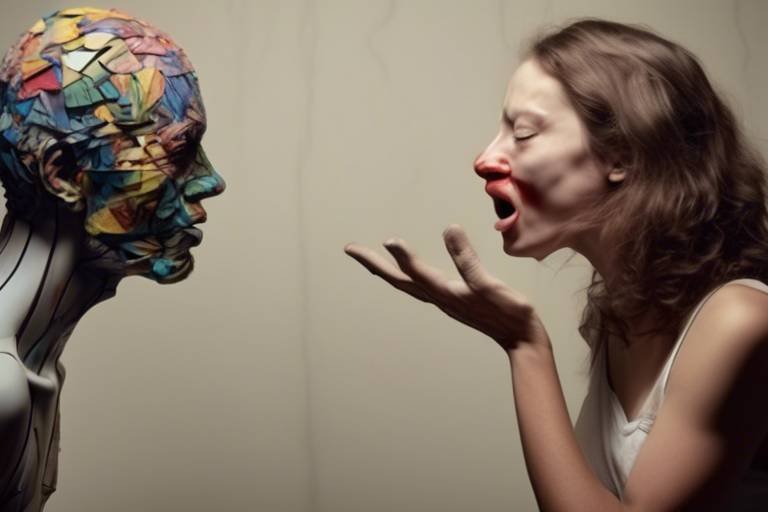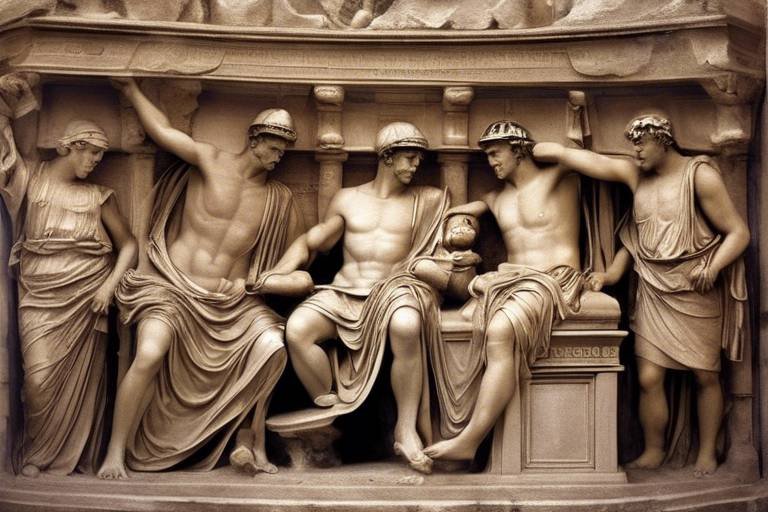The Role of Art in Understanding Human Emotions
Art plays a vital role in our understanding of human emotions, acting as a bridge between our innermost feelings and the external world. Through the creative expression of artists, we are able to delve into the complexities of emotions, unraveling the intricacies of joy, sorrow, love, and despair. Artistic creations have the remarkable ability to transcend language barriers and cultural differences, speaking to the universal aspects of human experience.
When we immerse ourselves in the visual representations of emotions found in art, we are confronted with a mirror reflecting our own inner landscapes. The brushstrokes, colors, and forms used by artists capture the essence of emotions in a tangible form, allowing us to connect with our feelings on a deeper level. Whether it's a vibrant painting that exudes happiness or a somber sculpture that evokes melancholy, art has the power to evoke a myriad of emotions within us.
Moreover, art serves as a therapeutic tool for emotional expression, providing individuals with a creative outlet to channel their feelings. Engaging in the process of creating art or simply experiencing it can be a cathartic experience, enabling us to release pent-up emotions and gain clarity in our thoughts. Art therapy has been recognized for its ability to promote emotional healing and self-discovery, offering a safe space for individuals to explore and confront their innermost struggles.
Across different cultures and societies, art reflects the unique ways in which emotions are perceived and expressed. Cultural backgrounds and societal norms influence the artistic representations of emotions, shaping the narratives and symbols used in artworks. By examining art through a cultural lens, we gain insight into the diverse perspectives on emotions and the varying ways in which they are interpreted and valued.
Symbolism plays a significant role in evoking emotional resonance in art, as symbols and metaphors can convey complex emotions with profound impact. Whether it's a rose symbolizing love or a storm representing turmoil, these visual cues trigger emotional responses that resonate with viewers on a personal or universal level. Through the language of symbols, art communicates the depth and breadth of human emotions, transcending linguistic barriers to touch our hearts and minds.
Artistic movements throughout history have been marked by the exploration of emotional themes, reflecting the evolving values and beliefs of society. From the emotional intensity of Romanticism to the fragmented realities of Cubism, each artistic movement captures the spirit of its time through the expression of emotions. By tracing the evolution of emotional themes in art, we witness the shifting tides of human experience and the enduring relevance of emotions in artistic expression.
Art museums serve as spaces that curate and present artworks with the intention of evoking emotional responses in viewers. These cultural institutions create environments that encourage contemplation, empathy, and connection through the appreciation of art. By engaging with artworks in a museum setting, visitors are invited to explore their emotional responses and engage in meaningful dialogue with the art and with themselves.
Art criticism plays a crucial role in the analysis and interpretation of the emotional content of artworks, offering insights into the intentions and effects of artistic expression. Critics and scholars delve into the nuances of emotional themes, dissecting the visual language and symbolism used by artists to convey feelings. Through critical analysis, we gain a deeper understanding of the emotional impact of art and the ways in which it shapes our perceptions and experiences.
Art education plays a transformative role in nurturing emotional intelligence, empathy, and self-awareness in individuals of all ages. By integrating art into educational curricula, students are exposed to diverse forms of creative expression that encourage emotional exploration and reflection. Through artistic practice and appreciation, individuals develop a deeper understanding of human emotions and cultivate the skills needed to navigate the complexities of the emotional landscape.

Visual Representation of Emotions
Exploring how art serves as a powerful medium to express, evoke, and comprehend human emotions, influencing our perceptions and connections with the world around us.
Artistic depictions play a profound role in visually capturing and conveying complex human emotions. Through the skillful use of colors, shapes, and forms, artists offer viewers a unique insight into the depth and diversity of our feelings. Imagine a painting that conveys the raw intensity of love or the melancholy of loss with just a brushstroke. These visual representations not only mirror our emotional experiences but also provide a mirror through which we can reflect on our own inner worlds.

Art as Therapy for Emotional Expression
Art has long been recognized as a powerful form of therapy for emotional expression. Through the act of creating or experiencing art, individuals can delve into their innermost thoughts and feelings, allowing for a cathartic release of emotions. This therapeutic process enables individuals to explore and process complex emotions in a safe and creative environment.
Art serves as a medium through which individuals can externalize their internal struggles, fears, and joys. Whether through painting, sculpture, music, or dance, art provides a non-verbal outlet for emotional expression, allowing individuals to communicate and make sense of their feelings in a profound and meaningful way.
One of the key benefits of using art as therapy is its ability to transcend language barriers. Emotions that may be difficult to articulate verbally can be expressed through visual or auditory means, bridging the gap between the conscious and subconscious mind. This form of expression can be particularly beneficial for individuals who struggle to verbalize their emotions or past traumas.
Moreover, the process of creating art can be inherently therapeutic, as it encourages individuals to focus on the present moment and engage in a meditative and mindful practice. The act of painting, drawing, or sculpting can help individuals channel their emotions into a tangible form, providing a sense of control and empowerment over their inner experiences.
Art therapy is not limited to creating art; it also encompasses the experience of engaging with artworks created by others. Visiting art galleries, museums, or attending art therapy sessions can evoke a range of emotions and stimulate introspection. By immersing oneself in the artistic expressions of others, individuals can gain new insights into their own emotional landscapes.
Overall, art as therapy offers a holistic approach to emotional expression and healing. By integrating artistic practices into therapeutic interventions, individuals can tap into their creativity, resilience, and inner wisdom to navigate the complexities of human emotions.

Cultural Influence on Emotional Art
Art is a universal language that transcends boundaries, but its interpretation and expression are deeply influenced by cultural backgrounds and societal norms. The way emotions are depicted in art varies significantly across different regions and time periods, reflecting the unique perspectives and values of each culture. For example, while some cultures may prioritize individual emotions and experiences in art, others may emphasize collective emotions or spiritual connections.
Moreover, cultural traditions and historical events play a crucial role in shaping the emotional content of art. Artworks often serve as reflections of the collective psyche of a society, mirroring its triumphs, struggles, and aspirations. The emotional resonance of art is intricately linked to the cultural context in which it is created, offering insights into the values, beliefs, and emotional experiences of a particular community.
Furthermore, the interpretation of emotions in art is also influenced by cultural symbolism and iconography. Certain symbols may hold specific emotional meanings in one culture but carry entirely different connotations in another. Understanding the cultural context of art is essential for appreciating the nuances of emotional expression and symbolism embedded in artworks.

Symbolism and Emotional Resonance
Exploring how art serves as a powerful medium to express, evoke, and comprehend human emotions, influencing our perceptions and connections with the world around us.
Symbolism plays a crucial role in art, as it has the power to evoke deep emotional responses and resonate with viewers on a personal or universal level. When an artist incorporates symbols and metaphors into their work, they are inviting the audience to delve beyond the surface and explore the layers of meaning hidden within. Just like a well-crafted metaphor in literature, symbolic elements in art can speak directly to our emotions, bypassing the constraints of language and logic.
Consider a painting where a solitary tree stands tall against a fiery sunset. The tree, often symbolizing strength and resilience, may evoke feelings of perseverance and hope in the viewer. The vibrant colors of the sunset could symbolize a sense of closure or new beginnings, stirring emotions of nostalgia or anticipation. Through these symbolic representations, the artist creates a visual language that speaks directly to the heart, transcending mere aesthetics to touch the soul.
Furthermore, symbols in art can carry cultural significance, adding layers of meaning that resonate with specific communities or traditions. For example, the lotus flower, a common symbol in Eastern art, represents purity and enlightenment in many Asian cultures. When a viewer familiar with this symbolism encounters a lotus depicted in a painting, they may experience a profound emotional connection rooted in shared cultural understanding.
In essence, symbolism in art serves as a bridge between the tangible and the intangible, the visible and the unseen. It invites us to explore the depths of our emotions, triggering responses that go beyond words. By engaging with the symbolic language of art, viewers can embark on a journey of emotional discovery, connecting with their innermost feelings and experiences in a profound and transformative way.

Artistic Movements and Emotional Themes
Artistic movements throughout history have been deeply intertwined with emotional themes, reflecting the evolving perspectives and values of society. From the emotional intensity of Romanticism to the fragmented emotions of Cubism, each movement offers a unique lens through which to explore human feelings. For example, the vibrant colors and swirling brushstrokes of Impressionism aimed to capture fleeting moments and emotions, emphasizing the beauty of everyday life.
Similarly, Surrealism delved into the realm of the subconscious, tapping into dreams and desires to express deep-seated emotions and thoughts. The abstract expressionism movement, with its spontaneous and gestural approach, sought to convey raw emotions and inner turmoil on canvas, inviting viewers to interpret and connect with the artist's emotional state.
Moreover, the minimalist movement stripped art down to its essential elements, focusing on simplicity and purity to evoke contemplation and introspection. By exploring these various artistic movements and their emotional underpinnings, we gain a deeper understanding of how art has been used to express and reflect the complex tapestry of human emotions throughout history.

Art Museums and Emotional Impact
Art museums hold a profound influence on individuals by curating and presenting artworks that evoke a wide range of emotional responses. These spaces serve as sanctuaries where visitors can immerse themselves in the beauty and depth of artistic expression, provoking contemplation and introspection.
Walking through the halls of an art museum, one can experience a myriad of emotions triggered by the diverse artworks on display. From awe-inspiring masterpieces to thought-provoking contemporary pieces, each painting or sculpture has the power to stir the soul and ignite the imagination.
Moreover, art museums create a sense of connection between the viewer and the artist, bridging the gap between different time periods, cultures, and perspectives. The emotional impact of standing face-to-face with a renowned artwork can be transformative, leaving a lasting impression on the viewer's psyche.
These institutions not only preserve cultural heritage but also serve as educational platforms for fostering empathy and understanding. By engaging with art that conveys deep emotional messages, visitors can develop a heightened sense of compassion and appreciation for the human experience.

Art Criticism and Emotional Analysis
Exploring how art serves as a powerful medium to express, evoke, and comprehend human emotions, influencing our perceptions and connections with the world around us.
Art criticism plays a crucial role in delving into the emotional depths of artworks, dissecting the nuances of expression and meaning embedded within them. Critics and scholars meticulously analyze the emotional content of art pieces, unraveling the artist's intentions and the impact on viewers. Through critical evaluation, they offer insights into the emotional resonance of artworks, shedding light on the intricate layers of human emotions portrayed.
Emotional analysis in art criticism goes beyond surface interpretations, diving into the subconscious realms of the artist's psyche and the emotional responses evoked in the audience. Critics explore how colors, composition, symbolism, and techniques contribute to the emotional impact of a piece, unraveling the complex interplay between form and feeling. By scrutinizing the emotional nuances of artworks, critics provide a deeper understanding of the human experience encapsulated within the art, inviting viewers to engage with their own emotions and interpretations.
Moreover, emotional analysis in art criticism extends to contextual considerations, examining how societal, cultural, and historical factors influence the emotional portrayal and reception of art. Critics navigate through the layers of context to unravel the emotional tapestry woven into artworks, elucidating the connections between artistic expression and the broader emotional landscape of a particular era or culture. Through meticulous observation and interpretation, art critics offer a lens through which viewers can explore the emotional depths of art and connect with the universal language of human emotions.
Art criticism not only enhances our appreciation of art but also deepens our emotional intelligence by fostering empathy, introspection, and critical thinking. By engaging with the emotional analyses provided by critics, viewers are encouraged to reflect on their own emotional responses to art, fostering a deeper connection with the profound emotional narratives embedded within artworks. Through the lens of art criticism, we embark on a journey of emotional discovery, exploring the intricate interplay of art, emotions, and human experience.

Art Education and Emotional Intelligence
Art education plays a crucial role in nurturing emotional intelligence and fostering a deeper understanding of human emotions. By engaging with various forms of art, individuals can develop empathy, self-awareness, and the ability to recognize and express their feelings in a creative manner. Through artistic practices such as painting, sculpture, music, and dance, students are encouraged to explore their emotions, thoughts, and experiences, leading to enhanced emotional intelligence.
Moreover, art education encourages individuals to appreciate the diverse range of emotions portrayed in artworks, allowing them to connect with different perspectives and experiences. By studying the emotional content of various art forms, students can develop a more nuanced understanding of human emotions and the complexities of interpersonal relationships. This not only enriches their artistic skills but also cultivates a deeper sense of empathy and compassion towards others.
Art classes often provide a safe and supportive environment for individuals to express themselves freely without judgment. Through creative activities and projects, students can channel their emotions into artistic creations, gaining a sense of catharsis and emotional release. This process of emotional expression through art can be particularly beneficial for individuals struggling with mental health issues or facing emotional challenges, offering them a therapeutic outlet for self-exploration and healing.
Furthermore, art education encourages critical thinking and reflection on the emotional impact of artworks, prompting students to analyze and interpret the underlying messages and themes. By engaging in discussions about the emotional content of art pieces, individuals can develop their analytical skills and deepen their emotional intelligence. This not only enhances their appreciation for art but also equips them with valuable tools for understanding and navigating their own emotions and those of others.
In conclusion, art education serves as a powerful tool for enhancing emotional intelligence, promoting empathy, self-awareness, and creative expression. By incorporating art into educational curricula, schools and institutions can empower individuals to develop a deeper understanding of human emotions, fostering a more compassionate and emotionally intelligent society.
Frequently Asked Questions
- What is the significance of art in understanding human emotions?
Art plays a crucial role in understanding human emotions by providing a visual and expressive medium to convey complex feelings that may be difficult to articulate verbally. Through art, individuals can explore and process their emotions, gaining insights into their own psyche and connecting with the emotions of others.
- How does art serve as therapy for emotional expression?
Creating or experiencing art can act as a form of therapy for emotional expression, allowing individuals to channel their feelings into creative outlets. Art provides a safe space for emotional exploration and release, enabling individuals to express and confront their emotions in a constructive and healing manner.
- What role do art museums play in evoking emotional responses?
Art museums serve as spaces that curate and present artworks in a way that stimulates emotional responses in viewers. By showcasing a diverse range of artistic expressions, museums create opportunities for contemplation, reflection, and empathy, fostering emotional connections between the audience and the artworks on display.



















